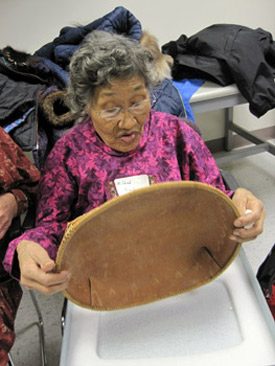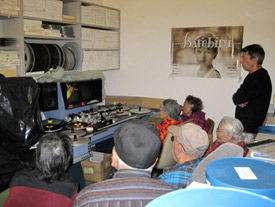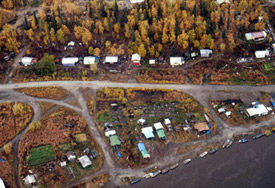Shungnak
Shungnak (Issingnak in the Inupiaq language) is located on the west bank of the Kobuk River, about ten miles downriver from Kobuk and 150 miles east of Kotzebue. The residents of Shungnak are Kuuvangmiut Inupiat Eskimos. Shungnak was established in the 1920s when residents of Kobuk migrated ten miles downstream because of river erosion and flooding. The new village was first named "Kochuk" but later changed to Shungnak, which is based on the Inupiaq word for jade, a stone found extensively in the area.
The city government was incorporated in 1967, but also is under the jurisdiction of the Northwest Arctic Borough, and has a federally recognized tribe. The estimated 2011 population was 261. The community remains highly dependent upon subsistence activities, and has a strong arts and crafts industry where residents make and sell finely-crafted birch bark baskets, masks, mukluks, parkas, hats, and mittens.

Mildred Black examines a birch bark basket at the University of Alaska Museum of the North, November 16, 2011.
Elders from Shungnak visited the University of Alaska Fairbanks on November 14-17, 2011 to look at collections and decide what they most wanted to have accessible online. Neal Sheldon, Edna Commack, Josie Woods, Mildred Black, Robert Lee, Bernice Custer, and Sally Custer looked at 1957 census records in the Albert Heinrich Papers and photos in the Charles Crabaugh, and Richard and Florence Collins Collections in the Alaska and Polar Regions Collections and Archives, Elmer E. Rasmuson Library.

Watching original film footage with Leonard Kamerling, Curator of Film, at the Alaska Center for Documentary Film, November 16, 2011.
They looked at baskets, fur clothing, and stone and bone archeological material at the University of Alaska Museum of the North, and viewed original footage from the “Drums of Winter” movie at the Alaska Center for Documentary Film. They also reviewed Native language material at the Alaska Native Language Archive. Several of these collections are now available online and accessible through this portal.


